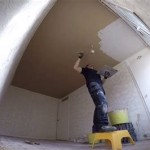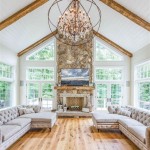High Ceiling Bedroom Paint Ideas: Maximizing Space and Style
Bedrooms with high ceilings offer a unique architectural advantage, creating a sense of spaciousness and grandeur. However, they also present a design challenge: how to properly utilize the height without making the room feel cold or cavernous. Paint plays a crucial role in addressing this challenge, influencing the perceived size, warmth, and overall aesthetic of the bedroom. Selecting the right paint colors and application techniques can dramatically transform a high-ceilinged bedroom into a comfortable and visually appealing sanctuary.
This article explores various paint ideas for bedrooms with high ceilings, providing insights into color selection, application strategies, and design considerations. By understanding these principles, homeowners can effectively leverage the vertical space and create a bedroom that is both stylish and inviting.
Understanding the Impact of Color
Color psychology profoundly affects the ambiance of a room. In a high-ceilinged bedroom, the impact of color is magnified due to the increased surface area. Light colors tend to make a space feel larger and more airy, while dark colors can create a sense of intimacy and warmth. Neutral tones offer versatility and can be easily paired with other design elements. When selecting paint colors, it is essential to consider the existing furniture, flooring, and natural light conditions.
For instance, if the bedroom receives ample natural light, cooler tones like blues and greens can create a tranquil and refreshing atmosphere. Conversely, if the room lacks natural light, warmer tones like yellows and oranges can inject a sense of sunshine and energy. Neutral colors such as grays, beiges, and whites provide a blank canvas that can be customized with colorful accents through bedding, artwork, and accessories.
Beyond the overall color scheme, consider the undertones of each color. A seemingly neutral gray can have cool blue undertones or warm brown undertones. These subtle undertones can significantly impact the overall feel of the room, particularly when combined with the existing light and furnishings. Sampling paint colors in the actual room before committing to a full application is highly recommended to assess how the colors appear under different lighting conditions.
Techniques for Painting High Walls
Painting high walls requires a different approach than painting standard-height walls. Safety is paramount; a sturdy ladder or scaffolding is essential. Investing in good-quality painting tools, such as extension poles for rollers and brushes, can also significantly improve efficiency and safety. Before beginning the painting process, thorough preparation is crucial. This includes cleaning the walls, patching any holes or imperfections, and applying a primer.
Priming is especially important for high walls, as it ensures proper adhesion of the paint and prevents uneven color absorption. Primer also helps to cover any existing stains or discoloration, creating a uniform surface for the new paint. When applying the paint, use long, even strokes to avoid streaks or drips. Work in manageable sections and allow each coat to dry completely before applying the next. Consider using a paint sprayer for large, high surfaces to achieve a smooth, professional finish.
Another technique to consider is creating a visual break in the wall. This can be achieved by painting a contrasting color on the upper portion of the wall, such as a lighter shade of the same color or a completely different hue. This technique effectively lowers the perceived height of the ceiling and adds visual interest. Alternatively, consider adding a decorative element, such as a painted stripe or a stenciled design, to break up the expanse of the wall. The placement of these elements can significantly impact the overall balance and proportion of the room.
Specific Color Palette Ideas
Several color palettes are particularly well-suited for bedrooms with high ceilings. These palettes take into account the need for both spaciousness and intimacy, creating a balanced and harmonious environment. One popular option is a monochromatic scheme, using different shades of the same color to create depth and visual interest. For example, a bedroom could feature a light gray ceiling, medium gray walls, and dark gray accents. This creates a sophisticated and calming atmosphere.
Another effective palette is a combination of neutral colors with a pop of color. For instance, the walls could be painted a soft beige or off-white, while a vibrant accent color, such as teal or coral, could be used for bedding, artwork, or a feature wall. This allows for flexibility and easy updating of the room's decor. The accent color draws the eye and can be strategically used to highlight architectural features or create a focal point.
For those seeking a more dramatic look, consider using darker colors, such as navy blue, charcoal gray, or deep green. These colors can create a cozy and inviting atmosphere, but it is important to use them judiciously. Pairing dark walls with lighter-colored ceilings and furnishings can prevent the room from feeling too small or oppressive. Good lighting is also essential when using dark colors to ensure that the room remains bright and well-lit.
Accent Walls and Feature Ceilings
An accent wall can be a powerful tool for defining space and adding visual interest in a high-ceilinged bedroom. Choosing a wall that naturally draws the eye, such as the wall behind the headboard, is a good starting point. The accent wall can then be painted a different color than the other walls, creating a focal point and adding depth to the room. Textural elements, such as wallpaper or a textured paint finish, can also be used to enhance the impact of the accent wall.
Considerations for choosing an accent wall color include the existing color palette of the room, the amount of natural light, and the desired mood. A bold, saturated color can create a dramatic statement, while a more subtle shade can add a touch of elegance and sophistication. Metallic paints or glazes can also be used to add a touch of glamour and reflect light, making the room feel brighter and more spacious.
In addition to accent walls, feature ceilings are another way to maximize the impact of high ceilings. Painting the ceiling a different color than the walls can draw the eye upward and emphasize the height of the room. A lighter color on the ceiling can make the room feel more airy, while a darker color can create a more intimate atmosphere. Stencils, murals, or geometric patterns can also be used to create a unique and eye-catching feature ceiling.
Creating Vertical Appeal
One of the primary goals when decorating a bedroom with high ceilings is to create vertical appeal. This involves drawing the eye upward and utilizing the height of the room to its full potential. Paint can play a significant role in achieving this goal. Vertical stripes, for example, can create the illusion of greater height. These stripes can be painted directly onto the wall or incorporated through wallpaper. The width and spacing of the stripes can be adjusted to suit the size and style of the room.
Another technique is to use a gradient effect, gradually transitioning from a darker color at the bottom of the wall to a lighter color at the top. This creates a sense of upward movement and can make the ceiling feel even higher. Ombre effects, where the colors blend seamlessly together, can also be used to achieve a similar result. This technique requires careful blending and layering of the paints to create a smooth and gradual transition.
In addition to paint, architectural details such as crown molding and wainscoting can also enhance vertical appeal. Painting these details in a contrasting color can highlight their presence and draw the eye upward. Tall, narrow artwork or mirrors can also be strategically placed on the walls to emphasize the height of the room. These elements should be positioned in a way that creates balance and proportion, avoiding a cluttered or overwhelming effect.
Lighting Considerations
Lighting is a critical element in any bedroom design, but it is particularly important in rooms with high ceilings. Poor lighting can make the room feel dark and cavernous, while well-planned lighting can create a warm and inviting atmosphere. The choice of paint colors should be considered in conjunction with the lighting plan. Darker colors require more light to prevent the room from feeling too dim, while lighter colors can amplify natural light.
A combination of ambient, task, and accent lighting is ideal for a high-ceilinged bedroom. Ambient lighting provides overall illumination, while task lighting is used for specific activities such as reading or dressing. Accent lighting is used to highlight architectural features or artwork. Chandeliers or pendant lights can be used to fill the vertical space and add a touch of elegance. Recessed lighting can provide a clean and modern look, while wall sconces can add a soft and diffused light.
The color temperature of the light bulbs should also be considered. Warm white light (2700-3000K) creates a cozy and inviting atmosphere, while cool white light (3500-4100K) provides a brighter and more energizing light. The choice of color temperature depends on the desired mood and the specific activities that will be performed in the room. Dimmers can be used to adjust the brightness of the lights, allowing for greater control over the ambiance of the room. The placement of the lighting fixtures should be carefully planned to ensure that the room is evenly illuminated and that there are no dark corners.
Considering Furniture and Accessories
The selection of furniture and accessories plays a crucial role in complementing the paint colors and maximizing the potential of a high-ceilinged bedroom. Tall furniture, such as bookshelves or armoires, can help to fill the vertical space and create a sense of balance. Low-profile furniture, on the other hand, can emphasize the height of the ceiling and create a more open and airy feel. The style of the furniture should be consistent with the overall design aesthetic of the room.
Accessories such as artwork, mirrors, and textiles can be used to add color, texture, and visual interest. Large-scale artwork can make a bold statement and draw the eye upward. Mirrors can reflect light and make the room feel larger. Textiles such as curtains, rugs, and bedding can add warmth and comfort. The colors and patterns of the accessories should complement the paint colors and create a cohesive and harmonious look.
It is important to avoid cluttering the room with too much furniture or accessories. A minimalist approach can often be more effective in showcasing the height of the ceiling and creating a sense of spaciousness. Focus on selecting a few key pieces that are both functional and visually appealing. The placement of furniture and accessories should be carefully considered to create a balanced and inviting environment. The use of vertical storage solutions, such as tall shelves or hanging organizers, can help to maximize space and keep the room tidy.

Best Paint Colors For High Ceiling Rooms Prestige Painting

Interior Design Ideas Grey Shingle Home

Those Darn High Ceilings

Best Paint Colors For High Ceiling Rooms Prestige Painting

How To Paint Extra High Vaulted Ceilings Young House Love

The Best Wall Paint Colors For Rooms With High Ceilings Lrv More

6 Painted Ceiling Designs And Tips For Painting Ceilings

How To Decorate A Living Room With High Ceilings Redesigned Classics

Creative Ideas For High Ceilings Decoist
:strip_icc()/living-room-high-ceiling-fireplace-b175ca6aad2a4cc5873b95d6f7b46947.jpg?strip=all)
9 Ceiling Paint Colors Designers Love That Aren T White
Related Posts








